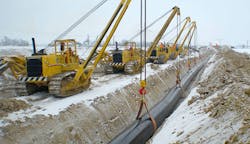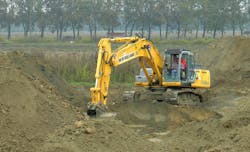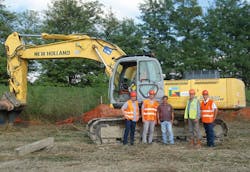High-VI Fluid Cuts Fleet-Fuel Costs
Download this article as a .PDF
For more than 60 years, Italian construction company Ghizzoni SpA, Vidalenzo di Polesine has focused on the construction of pipelines for oil, gas, and water. They have always held a leading position in their market segment, and a 2013 merger that made it part of Nuova Ghizzoni SpA only further reinforced its leading position in this challenging segment.
Ghizzoni’s large projects require a sizable fleet of highly productive construction machinery. Not surprisingly, then, fuel cost makes up a substantial part of Ghizzoni’s operating cost. Naturally, then, Giovanni Maffia, Ghizzoni’s construction engineer, is constantly on the lookout for new fuel savings options.
When Maffia learned about Dynavis technology for hydraulic fluids, he contacted Evonik Industries to find out if this could be a practical way to reduce his company’s fuel costs. After a brief phone call, Dynavis team members met with Maffia and his colleagues in northern Italy to put Dynavis to the test.
A project representative of Ghizzoni’s expertise in pipe laying excavation was the construction of the Poggio Rentico-Cremona pipeline, which involved laying of a 48-in. pipeline spanning 114 km (71 miles) across Italy’s Padan plain. A fleet of 14 New Holland crawler excavators was charged with the task of restoring the topsoil once the pipe laying was completed. For both Maffia and the Dynavis team, the question became, “How much fuel can be saved in a scenario like this?”
Viscosity and Viscosity Index
Dynavis technology is a chemical-additive package incorporated into any of several hydraulic oil base stocks by fluid suppliers to increase the fluid’s viscosity index (VI). Viscosity is probably the single most important characteristic of hydraulic fluid, or just about any other lubricant. If a fluid’s viscosity is too high, it may not achieve full-film lubrication, which could result in rapid wear from metal-to-metal contact between moving parts. Hydraulic equipment operating in cold environments or during cold startup is prone to this condition because base oils tend to become more viscous (thicker) at lower temperatures.
On the other hand, if a fluid’s viscosity is too low, the thin fluid will be unable to keep moving parts separated under load. The result will be the same—rapid wear from metal-to-metal contact. This often occurs when hydraulic systems operate in hot environments or when heavy loading heats up the fluid. Temperature, again, is the culprit because just as hydraulic base oil tends to become thicker at lower temperatures, it tends to become thinner at higher temperatures.
Fluid suppliers circumvent this problem to some extent by adding VI improvers to base oil. The higher a fluid’s viscosity index, the less the fluid’s viscosity is affected by temperature. So a fluid with a high VI will be less prone to thickening at low temperatures and thinning at high temperatures than a fluid with a low VI.
Commencing with Tests
Maffia and his colleagues brought the Dynavis team to the overall project, the site, and the equipment. As the Dynavis team became more familiar with the details, they began examining the equipment and studying the operating conditions of the site in discussions with the Ghizzoni project manager and excavator operators.
The first trial used two New Holland E385B excavators, which had the hydraulic fluid (Mobil HLPD 46) drained from their 413-l (109-gal) reservoirs. The reservoirs were flushed, then replenished with Total Equivis 46HE fluid, a Dynavis formulated hydraulic fluid. With a fleet of 14 almost-identical excavators assigned to the singular task of restoring the topography of the pipeline route, the test presented an opportunity to accurately collect test results that could be extrapolated to the entire fleet.
Professional operators of large fleets of construction equipment excel at gathering detailed operating data and fuel consumption stats accurate down to the hour. For example, Ghizzoni’s New Holland crawler excavator 385B with the asset number AZ663.2 showed 4,849 operating hours on its counter before the test start. The first test evaluation was made when the machine logged 4,952 operating hours. Fuel consumption of the 125 hours preceding the test was used as a comparable quantity.
Evaluating Test Results
The test evaluation determined that the excavator had achieved an average reduction in fuel consumption of 9.89 %. Based on a fuel price of 1.45 Euro/l ($6.00/gal) the excavator had saved 35 Euro ($38.50) per day in fuel. More importantly, the results from this single excavator suggested a potential savings of 10,000 Euro ($11,000) per month could be achieved for the entire fleet.
The second test excavator had been used for several different tasks before the start of the test. Therefore, members from both teams were somewhat unsure of what to expect as far as results. Nonetheless, results from this excavator showed fuel savings exceeding 18%.
Official documentation concluded that a 9.89% reduction in fuel consumption could be expected by using hydraulic fluid incorporating Dynavis technology. A qualifying statement stated that this number may not, in all cases, represent the maximum savings potential. The test results speak volumes about the ability of Dynavis technology to save fuel.
“Since the very beginning,” Maffia says, “the machine operators experienced a better handling of the machine. Also really important for us is a reduction in fuel consumption of around 10%. The hydraulic fluid with Dynavis additive is a good choice.”





